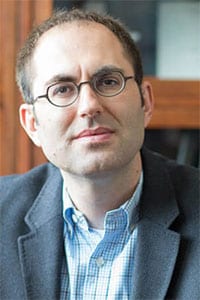A project combining basic virology, mass spectrometry and computation has given scientists a greatly expanded, in-depth look at the cell-to-cell transmission of HIV, and the cascading changes within cells that spark this potent attack.

Paul Ahlquist, director of the Rowe Center for Virology at the Morgridge Institute for Research, led the effort to understand how HIV — the virus that causes AIDS — reorganizes the infected cell, making literally thousands of changes to the host proteome, the complex total protein pool of the cell, to assist in transmitting virus to healthy immune cells.
Viruses are usually thought of as being spread when infectious virion particles are released to roam free of the infected cell. However, HIV-infected cells most efficiently transmit infection by forming direct cell-to-cell contacts with uninfected cells called “virological synapses” — not unlike the connections nerve cells make to communicate with one another.
The connection takes place when an HIV envelope protein on the infected cell surface “grabs” its receptor, known as CD4, on an uninfected T cell. The resulting patches of cell-to-cell contact are used to transmit infectious virions directly to the uninfected cell.
The new results show that making this cell-to-cell connection unleashes a hornet’s nest of activity in the infected cell to drive transmission.

Ahlquist, also a UW–Madison professor of molecular virology, oncology and plant pathology, teamed with Morgridge and UW–Madison mass spectrometry pioneer Josh Coon to capture these proteomic changes at both the 5-minute and 60-minute stage after CD4 contact. Morgridge Virology Investigator and UW–Madison professor Anthony Gitter’s group used advanced computation to identify the significant changes in the HIV-infected cell proteome and organize them into functional pathways for further analysis.
A further key collaborator on this study was UW–Madison professor Nathan Sherer, whose work on many aspects of HIV biology includes pivotal early contributions to recognizing the role of direct cell-to-cell contacts in infection spread by HIV and its relatives. Lead authors on the paper were James Bruce and Eunju Park. The results, first published on July 17 in the journal PLOS Pathogens, provide virologists with a wealth of data for ongoing analysis, along with multiple important conclusions and leads.
“We’ve generated an extensive catalogue of the changes induced by this important process of cell-cell contact and virological synapse formation,” says Ahlquist. “The results describe what happens when an HIV-infected cell contacts an uninfected cell and goes into its dynamic attack mode, like a submarine that has just spotted an enemy ship.”

Already at the 5-minute mark, the mass spectrometry revealed 103 significant changes in protein levels compared to normal cells, and 1,085 changes in protein phosphorylations, which are reactions that modify proteins to turn their activities on or off. The group did a control study where it took away just the HIV envelope protein from infected cells, and the phosphorylation changes decreased from over 1,000 to about a dozen — crucial evidence that direct cell-to-cell contact is key to inducing HIV-infected cells to go to attack state.
Even more tell-tale changes happened at the 60-minute mark, with another 106 changes detected in protein levels and 976 in phosphorylation.
“Interestingly, in the 60-minute time frame, many of the changes had to do with the cell cycle — that is, the cycle by which cells grow and divide,” Ahlquist says. “That’s a little surprising, because cell division is not essential to HIV infection.”
That finding led the team to a new clue to why HIV is driving these changes. They found that an enzyme called Aurora Kinase B (AURKB) gets dramatically suppressed at the 60-minute mark. Aurora Kinase B is a key regulator of cell division.
“This was very interesting because other recent papers showed that, in newly HIV infected cells, AURKB is stimulated,” he adds. “Now we see that, at this later specific step in the virus life cycle, it’s activity is shut down.”
The team’s results further showed that, although AURKB is primarily known for acting at cellular chromosomes, it also suppresses HIV spread at cell surface virological synapses. The researchers additionally found that, when an infected cell contacts an uninfected cell, HIV dramatically relocalizes AURKB from throughout the cell into the nucleus, blocking AURKB’s ability to suppress HIV spread at the cell surface.
Overall, the results imply that AURKB has additional roles beyond its known important functions in the cell cycle, and that HIV manipulates these roles to optimize its transmission to new cells.
Insights such as this could provide important new avenues for therapeutic intervention against HIV, particularly if drugs could help AURKB maintain its virus-fighting capacity during cell-to-cell transmission. Moreover, Ahlquist and his collaborators note, their study implicates other cell proteins and pathways in HIV transmission – providing additional antiviral targets – and their extensive data provides strong foundations for further valuable studies to advance understanding of HIV function and improve HIV control.
